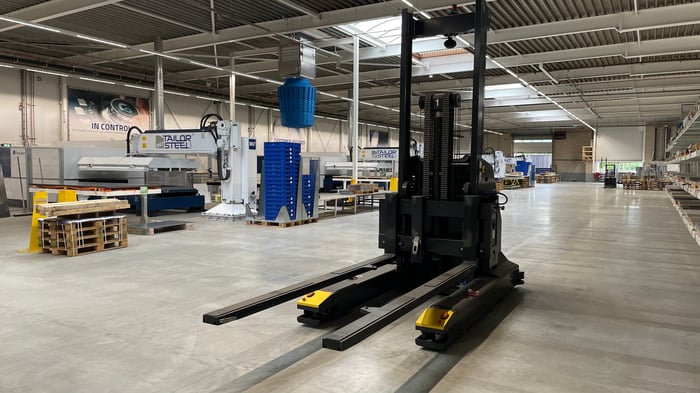Did you know that ensuring a healthy indoor climate in your production facility can effectively reduce absenteeism rates? A clean, cool, and fresh workspace guarantees happy employees. And while awareness of the need for a healthy and comfortable working environment is growing, the huge shortage of staff in the labor market is getting even more prominent. All the more reason to ensure a healthy and productive climate in your production facility - with stable indoor temperatures and air humidity, and optimal air quality.
This blog provides five tips to create an indoor climate that keeps your employees happy, healthy, and productive.
Improving your indoor air quality
The recent pandemic has taught us that optimal indoor air quality is of the utmost importance for our health. Optimal air quality not only protects us from pathogen contamination; it also ensures workers are not affected by (harmful) fumes and dust released in the production process. Besides, clean CO2-rich air helps boost concentration and productivity. To achieve optimal indoor air quality, there is only one thing you can do…
Tip #1: Ventilation is KEY
Yes, ventilation is key. It is necessary to keep a constant flow of (fresh) filtered air in a room or building to ensure optimal air quality. There are, of course, several ways to provide ventilation. What you want to avoid is continuously re-ventilating used air. This only moves the air and does nothing for the air quality. Ventilation by opening the windows is the easiest and cheapest way to ventilate a building. However, this can affect the indoor temperature negatively, causing the temperature to drop or rise beyond comfort levels. Noise nuisance may also be a reason not to open windows. The best option for sufficient ventilation is to install a climate system that ventilates using (fresh) filtered air and controls for the blow-in temperature of the air.
Controlling the indoor air humidity
Keeping the indoor air humidity in that sweet spot that is not too dry yet not too moist is vital to our health and comfort and many production processes. Air that is too dry - often caused by traditional AC in their cooling process - irritates the eyes and throat and increases the chance of virus transmission. Besides, too dry air may cause static charge and increase the chance of condense formation during the production process. On the other hand, too humid air may cause difficulty breathing, general discomfort, and deformation or molding of production materials.
Tip #2: Keep your air not too dry, not too humid
Our tip here is to (simply) control for the indoor air humidity, ensuring that the humidity level stays well between too dry and too humid. We recommend a humidity level between 40 and 60%. If you have a climate system that dehumidifies the air in the cooling process, ensure that you provide the air with enough moisture by other means, like a humidifier. The best option is to go for a climate system that automatically controls the humidity levels in your facility.
Click here for more information on why optimal air humidity is important and what technology helps you achieve this.
A stable and comfortable temperature - all year round
The most desirable situation is to create an indoor climate with stable, comfortable, and productive temperatures. Over the last decade(s), production facilities have struggled to achieve this. The global temperature rise has caused indoor temperatures to skyrocket. This has severe detrimental effects on employee health and productivity as well as production processes. However, some straightforward tips help create a more comfortable and beneficial temperature in production facilities.
Tip #3: Keep your internal heat load at a minimum
The internal heat load of a building is one of the factors that influence the indoor temperature. Whereas you cannot control the sun and the outdoor temperature, you can control how it affects your internal heat load. For instance, there are several ways to shield your windows and skylights from the sunlight passing through. Another way to keep your internal heat load at a minimum is to change your lighting to LED lights. This type of lighting produces very little to zero heat.
More tips? Read our blog: How to calculate and reduce the heat load of your production facility
Tip #4: Keep in mind your production process
Production processes often release a lot of heat, either because of the production process itself or the heat generated by the production machines. If at all possible, consider placing heat screens around the heat-producing equipment to keep the heat from spreading throughout the building. Exhaustion pipes that remove the heat generated in production may also provide a solution. Be mindful, however, of the over and under pressure affected by air exhaustion.
Tip #5: Introduce a cooling system
The most effective way to control the indoor temperature is to opt for a cooling system. These systems automatically control the temperature, adding or lessening cooling whenever there is a fluctuation in temperature and ensuring a stable temperature all year round. The major drawback of installing a cooling system is that oftentimes, these systems consume immense amounts of energy to achieve the required cooling capacity for production facilities.
Luckily, there is a highly sustainable and effective cooling technology on the market for large buildings: two-stage evaporative cooling. For more information on this innovative cooling technique, check out our page: ‘two-stage evaporative cooling’
For a clear comparison between this innovative cooling technique and conventional airconditioning, check out our page: two-stage evaporative cooling vs airconditioning.
Energy-efficient indoor climate control for production facilities
The above shows there are many things you can do to improve the indoor climate of your production building. Usually, a combination of these options should be employed to create a healthy and productive work environment. Often a climate control system will need to be opted for, to control the temperature, indoor air humidity, and ventilation. These systems, however, generally consume a lot of energy, which is best avoided given the current energy crisis and sustainability goals. In our whitepaper 'challenges and opportunities for energy-efficient climate control',we discuss this issue further and provide you with thé solution. Download the whitepaper for free:
Would you rather directly speak to an industrial indoor climate specialist to discuss your challenges? Please feel free to fill out the form below with your request. We are happy to help.



